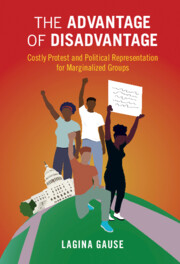Book contents
- Frontmatter
- Dedication
- Contents
- List of Figures
- List of Tables
- Acknowledgments
- 1 The Promise of Protest
- 2 Costly Protest and Political Representation
- 3 How Legislators Perceive Collective Action
- 4 How the Average Legislator Responds
- 5 The Limits of Costly Protest
- 6 Costly Protest in a Digitized World
- 7 The Democratic Value of Costly Protest
- 8 Appendices
- Bibliography
- Index
- Books in the Series
5 - The Limits of Costly Protest
Published online by Cambridge University Press: 17 February 2022
- Frontmatter
- Dedication
- Contents
- List of Figures
- List of Tables
- Acknowledgments
- 1 The Promise of Protest
- 2 Costly Protest and Political Representation
- 3 How Legislators Perceive Collective Action
- 4 How the Average Legislator Responds
- 5 The Limits of Costly Protest
- 6 Costly Protest in a Digitized World
- 7 The Democratic Value of Costly Protest
- 8 Appendices
- Bibliography
- Index
- Books in the Series
Summary
Gause contends that reelection incentives motivate legislators to support protest demands, especially as protesters’ resources decrease. However, how legislators respond to salient protest demands may depend on legislator or congressional district characteristics.The empirical models in the previous chapter include control variables to account for the influence of public opinion, partisanship, and legislators’ personal preferences on legislative behavior. Those empirical models provide evidence for the average legislator’s support of protesters’ preferences.
This chapter looks more closely at a legislators’ electoral context to evaluate whether certain legislators or congressional districts misalign with the theory of costly protest and legislative behavior. The results demonstrate that all legislators are responsive to the costly protest of their constituents. A legislator’s party, race, or electoral vulnerability changes the degree but seldom the direction of legislative voting behavior in favor of low-resource protesters.
Keywords
- Type
- Chapter
- Information
- The Advantage of DisadvantageCostly Protest and Political Representation for Marginalized Groups, pp. 120 - 140Publisher: Cambridge University PressPrint publication year: 2022

